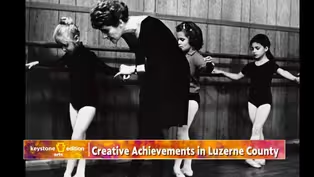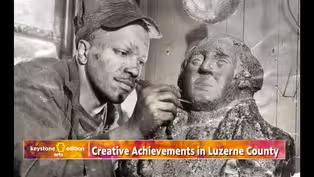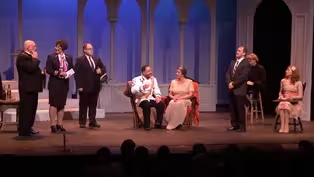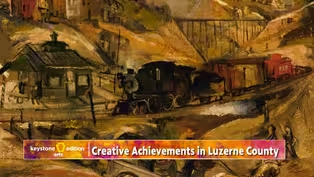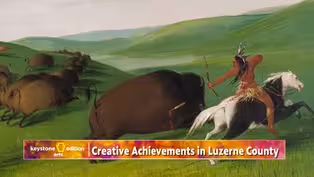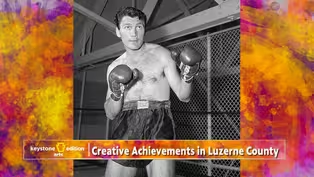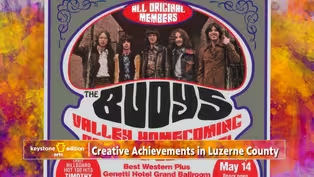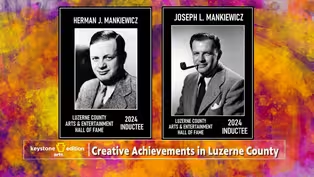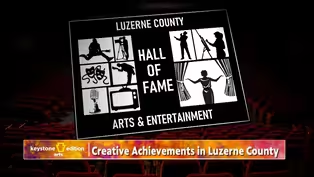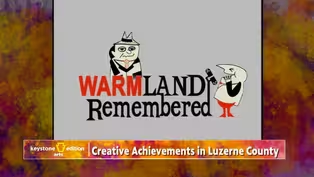Keystone Edition
Creative Achievements in Luzerne County
11/25/2024 | 26m 59sVideo has Closed Captions
Explore the origins of the Luzerne County Arts & Entertainment Hall of Fame
In November, the Luzerne County Arts & Entertainment Hall of Fame will induct its second class, recognizing local people for their artistic achievements within and outside our region, including national and international recognition. Keystone Edition: Arts will look at the origins of the Luzerne County Arts & Entertainment Hall of Fame and learn about some of the creative people included.
Problems playing video? | Closed Captioning Feedback
Problems playing video? | Closed Captioning Feedback
Keystone Edition is a local public television program presented by WVIA
Keystone Edition
Creative Achievements in Luzerne County
11/25/2024 | 26m 59sVideo has Closed Captions
In November, the Luzerne County Arts & Entertainment Hall of Fame will induct its second class, recognizing local people for their artistic achievements within and outside our region, including national and international recognition. Keystone Edition: Arts will look at the origins of the Luzerne County Arts & Entertainment Hall of Fame and learn about some of the creative people included.
Problems playing video? | Closed Captioning Feedback
How to Watch Keystone Edition
Keystone Edition is available to stream on pbs.org and the free PBS App, available on iPhone, Apple TV, Android TV, Android smartphones, Amazon Fire TV, Amazon Fire Tablet, Roku, Samsung Smart TV, and Vizio.
Providing Support for PBS.org
Learn Moreabout PBS online sponsorship- [Announcer] Live from your public media studios, WVIA presents "Keystone Edition Arts," a public affairs program that goes beyond the headlines to address issues in Northeastern and Central Pennsylvania.
This is "Keystone Edition Arts."
And now, Erika Funke.
- Welcome to "Keystone Edition Arts," where we'll celebrate a host of creative individuals who are lights to us all.
Sarah Scinto begins with a visit to one of the epicenters of the arts in Luzerne County.
(gentle bright music) - [Sarah] The Fine Arts Fiesta has been celebrated every May in downtown Wilkes-Barre for more than 65 years.
This vibrant event, recognized as the oldest full scale arts festival in Pennsylvania, showcases a wide variety of art forms, including juried art exhibits, dance and music performances, strolling entertainers, and puppet shows.
The Fine Arts Fiesta was created under the leadership of Annette Evans, with the assistance of Al Groh.
Evans was involved in numerous other arts initiatives, such as the Little Theater of Wilkes-Barre and the Northeastern Pennsylvania Philharmonic.
Al Groh founded the Theater Arts Program at Wilkes University and composed poetry, among other artistic endeavors.
Evans and Groh were inducted into the Luzerne County Arts and Entertainment Hall of Fame to recognize their passionate advocacy for the arts in Luzerne County.
Joining Evans in the Hall of Fame is jazz trumpeter and band leader Bobby Baird, the youngest member of the US Navy Band to be named soloist.
He played with many jazz greats, including Gene Krupa, and backed up singers like Rosemary Clooney and Peggy Lee.
Baird was also a familiar face at the Fine Arts Fiesta.
Barbara Weisberger, founder of the Pennsylvania Ballet and protege of George Balanchine, brought dancers to the Fine Arts Fiesta, as did Broadway veteran, dance school owner, and TV producer Joan Harris.
Artists Sue Hand and C. Edgar Patience showcased their respective painting and coal sculpture talents at the Fine Arts Fiesta.
Their contributions, along with those of many other Luzerne County Arts and Entertainment Hall of Fame members helped fulfill the Fiesta's mission of encouraging participation in and appreciation of the arts.
For "Keystone Edition Arts," I'm Sara Scinto, WVIA News.
- Sara Scinto saluting some of the important creative individuals who've been honored in the 2023 and 2024 with the induction into Luzerne County Arts and Entertainment Hall of Fame.
It wasn't very far from Public Square in downtown Wilkes-Barre where Herman and Joseph Mankiewicz spent some of their younger years.
Their biographer, Sydney Ladensohn Stern, tells us a story about Herman before they each made their mark in Hollywood for classic movies like "All About Eve" for Joe and "Citizen Kane" for Herman.
After waiting, it seems like forever, Herman received at last a beautiful bicycle as a gift from his parents.
When he wasn't supposed to, he took off for the Osterhout Public Library and parked his bike outside to explore the world of stories inside and found, in the meantime, that his cherished bicycle had been stolen and it was never recovered.
Ladensohn Stern makes a compelling case for the fact that Herman's heartbreak over his prized bike was so deep that he never recovered, but that he finally was able to work out his childhood loss and anguish through the symbol he created in that legendary movie, "Citizen Kane."
Rosebud.
Rosebud the sled became the emblem of that bicycle.
And that's an example of the importance of an entity such as the Luzerne County Arts and Entertainment Hall of Fame, a simple childhood instance, an incident in the life of a creative artist-to-be has touched millions of filmgoers and will continue to do so with its feeling for humanity.
A Hall of Fame can remind us of all the creative individuals with ties to this place and the ways they can show us who we've been and are and can possibly become.
We have as our guests on "Keystone Edition Arts" very talented people who can help us meet some of the Hall of Fame honorees, regrettably only some because there have been more than 30 already.
Tony Brooks is a Wilkes-Barre City council member, founder and executive director of the Wilkes-Barre Preservation Society.
He is chair of the WVIA Community Advisory Board and he has just received the Lifetime Achievement Award from the Greater Wyoming Valley Chamber of Commerce for his contributions to this community.
Too numerous to mention.
Maxim Furek, author and rock journalist from Northeastern Pennsylvania who has written music-centered books including "Somebody Else's Dream: Dakota, the Buoys, & 'Timothy'" and "The Jordan Brothers, a Musical Biography of Rock's Fortunate Sons."
He was also founder of Timothy: Northeastern Pennsylvania's First Popular Music Publication.
We've also spoken with Dr. Darlene Miller-Lanning, director of the Hope Horn Gallery at the University of Scranton, faculty member there, art history researcher, and author of numerous catalogs and books pertaining to art in Northeastern Pennsylvania.
Welcome to each of you.
Tony, we might always think of you, and that would be in connection with your art, with your history, love, and your work for preserving that history, but you don't seem to separate arts and history in your life.
As a founding member of the Hall of Fame, introduce us to the Luzerne County Hall of Fame and its mission.
- So the Hall of Fame started two years ago.
It was the brainchild of Joe Nardone, and I think a lot of people know, I mean, probably know who Joe Nardone is, particularly if you went to a dance at Sanssouci.
Joe and Bill O'Boyle from the Times Leader, they hooked up and they were the leadership team to bring recognition to hundreds and hundreds of people who either touched Luzerne County, born in Luzerne County, maybe had the bulk of their career in Luzerne County, maybe only spent a couple years in Luzerne County but have impacted art and music and entertainment in such a way that it serves as role models for people in Luzerne County today.
- And you have been tasked with leading the arts charge, right?
- Correct, so the Hall of Fame is separated between entertainment committee, which is basically music, and then the art side, which is far and wide because we go from sculptures to dancers to painters to all kinds of arts and make sure that we cover 'em.
And one of the other things that we have to work out is who in the past is deserving of the award and who is still alive deserving of the award, and we have to make sure we have a little balance there.
- And you can bring your love of history together with arts when you tell us about George Catlin.
- Oh, absolutely.
And I think this is the reason why I'm on the committee, is to give historical background of all these.
And, of course, George Catlin, you think about it, is our most famous export, more so than anthracite coal, 'cause George Catlin, you can still go see today, you can go to the Smithsonian, but think about this.
George Catlin was born where the Dunkin' Donuts is on Public Square back in 1796, went off to the Pennsylvania Academy of the Fine Arts, and decided to, well, if you think what a little boy, he's hearing about Lewis and Clark and all these wonderful exhibitions and traveling of the Native Americans on the Great Plains of the Missouri and Mississippi Rivers, and he wants to go see it for himself.
And thank God he did, because George Caitlin did it in such a way and at such a time right before a lot of these Indian tribes get wiped out by either our diseases or the bullets of our guns.
And thank God he did what he did, because he preserved for eternity all the history of these particular tribes on the Great Plains.
- And often he did portraits, didn't he, of some of the leaders of the tribes?
And there's such dignity and respect in his work.
- Correct, so he did chiefs, their wives, religious festivals, hunting buffalo.
He is the person who made the American buffalo an icon of American history.
You think about it.
We put the buffalo on our nickel.
We have it for so many different years.
But the most fascinating thing is, and I can see George Catlin's buffalo bull up on the screen, that that painting was in the Louvre in Paris and in the Oval Office at the White House.
Now, what other person from Wilkes-Barre could do that?
(chuckles) - George Catlin's the one.
- Right.
- And do we know that Annette Evans had an interest in George Catlin and wrote about him and brought some of his paintings back?
- Correct, she did an exhibition of George Catlin here, and she was a big fan of his.
And thank God we have Annette Evans too and all the work that she has done since, well, 1956, when she started the Fine Arts Fiesta.
Just wonderful.
- Wow, Tony, thank you.
We're wanting to not leave the Western United States as we move to actor Jack Palance, who was born in Lattimer Mines.
He was the son of a miner born into a Ukrainian family.
He, too, was a coal miner for a time before he turned to boxing.
Isn't that what we know?
He's well known for his roles in Westerns, including "Shane" and eventually "City Slickers."
And that's the movie for which he received an Oscar for the best supporting actor.
And we can't forget that in the midst of his acceptance speech, he did three one-armed pushups.
We remember that one.
Jack Palance has roots in coal.
It probably affected the roles he played, right?
Many tough guys.
Well, C. Edgar Patience, for him, coal was his art.
He was born here in West Pittston and learned coal carving from his father, who was the son of a former slave.
In the 1950s, his work began to receive critical acclaim and major corporations were commissioning his work.
Many pieces are now in national museums and collections around the US.
In 2021, his daughter, Juanita Patience Moss, was our guest and she talked about his father's legacy.
(gentle music) - I guess he got tired of just making little trinkets, and he looked at a piece of coal and he said, "Oh, I can do something else with that."
And his father probably said, "Oh no, we have to make a living here.
We have to make all these ashtrays and all these paper weights and make gifts and crafts for people coming to the area."
But that bust of George Washington sat in our dining room for years.
I remember that as a kid.
I don't know when my father started it, but I know it was finished when it went to the Anthracite Heritage Museum in Scranton.
There it is.
- [Erika] Wow.
And so he did carve a wide range of pieces, realistic works like the elephant and the Mack Trucks' bulldog.
- Yes.
- [Erika] That was a commission.
- [Juanita] I think when he was doing the abstract work, he just saw like that piece of coal right there.
He just decided, "Let me see where it will go.
Hopefully it will not fracture," and a lot of the pieces of coal did fracture.
Now that geodes belongs to me too.
I have that here in my home.
So I think he just said, "Well, let's see where it's going and then I will give it a name."
- [Erika] I think it was interesting to hear that he also would explore museums and books and look at the work of Henry Moore, who actually was from a mining family in England.
So there's a wonderful connection there.
- His legacy is that beautiful altar at King's College.
He felt that that was his premier work.
He was so happy to have had that permission to be able to do that.
So when people go to this church and they see that altar, and they see the beauty of it, and they remember their ancestors, not only the Corgan family that donated it, but the ancestors of other people who were in the Valley, I hope that they will remember how important coal was at one time.
(gentle dramatic music) - Dr. Juanita Patience Moss, speaking about her father, C. Edgar Patience, on "Keystone Edition Arts" in 2021.
He was inducted into the Luzerne County Hall of Fame in 2023.
Another significant visual artist who came from coal, we might say, is Franz Kline, and the impact of his body of work is international.
Dr. Darlene Miller-Lanning speaks with us in the Hope Horn Gallery at the University of Scranton to help us put Kline into perspective.
(gentle touching music) - For a lot of the artists that I know, the significance of his work to us is that he understood that painting and mining are actually very similar things, and both of them represent an encounter with revelation and loss.
And so you work to uncover something, to excavate something, to claim something, and that can be a process that has consequences.
And so it's not that he would paint an image of a coal breaker or of a mine, but there was this idea of that kind of activity and then what kind of mark that leaves on a landscape or maybe on a community or on a psyche, right?
We got that.
(laughs) We understood it.
And I think Klein himself maybe was kind of reluctant to make a direct connection and would always say, "Oh, you know, my work is open to interpretation."
But we were from here.
There was a show at the Whitney in the 1990s, and when you walked through that exhibition, there were paintings that were 7, 10 feet in scale, I mean, some of them were huge.
And there was a huge one called "Lehigh," and I'm from Mountain Top, which is near the Lehigh River near White Haven, and the thing felt like home.
(laughs) It just, again, it wasn't descriptive, it wasn't something literal, but if you go through Northeastern Pennsylvania in the winter and you see that kind of stark landscape and you see the girders and the old industrial sites that are there, and there's just this kind of linear sense of things that have been moved and torn and built, and there's balance and tension and contrast, and all of that was there.
It was just inherent in that painting.
Postmodern stuff isn't always pretty.
It can be very edgy in a lot of ways, but that willingness to confront a difficult subject, again, is something that I think that Klein was willing to do.
And he himself had seen enough trouble to understand that and to know that you had to kind of look at it and pick it up and regroup, and not in necessarily a literal descriptive kind of way.
It was part of a bigger process of trying to understand how things came together and how they could be used as a foundation moving forward.
(gentle touching music) - Dr. Darlene Miller-Lanning, director of the Hope Horn Gallery at the University of Scranton, speaking with us about Franz Klein, who was inducted into the Luzerne County Arts and Entertainment Hall of Fame on November 8, 2024.
George Balanchine has been called the foremost contemporary choreographer in the world of ballet.
The term modern has often been used.
Barbara Linches was the first child Balanchine admitted to his school, a real departure for him.
Barbara Linches Weisberger became a protege of Balanchine and went on to found the Pennsylvania Ballet.
WVIA produced a documentary on Barbara Weisberger and her achievements in 2007.
- The Pennsylvania Ballet played a very important and relevant part in the, you might call, the artistic greening of America.
(gentle dramatic music) There are a lot of companies that have developed from New York City Ballet, and Pennsylvania Ballet is one of the most honorable.
- I think that he could see future through Barbara Weisberger's kind of leadership potential.
And that, I think, is a critical notion and idea.
I am fond of saying that most companies reflect their artistic directors.
- There are times when I'm doing something and teaching and listening to myself saying something, and I'm thinking, "Gee, that's a Barbara Weisberger explanation."
- Money was nothing to her.
(laughs) It was just the love of ballet, the love of the people who were in it, the love of the children.
It's not an obsession, but it's close.
- She really is tenacious about that, about supporting creative artists.
- She knew that she had the support and the backing of her family.
And feeling that there were no objections to her doing this, I think it helped drive her to a greater efforts to try to do the best that she could.
- Most of my professional life had to do with building, with gathering people, working with people, loving them, committing to them and with them.
I don't think that while you're doing it, you're thinking of what's gonna happen, what people think.
It comes, somehow, if you're lucky, it comes in the way people really love you.
(gentle dramatic music) - Highlights from a documentary produced by WVIA titled "Barbara Weisberger: En Pointe" in 2007.
Ms. Barbara, as she was lovingly called, was inducted in 2023.
Those are only some of the significant features in the arts who've been inducted into the Luzerne County Art and Entertainment Hall of Fame, and now we turn to the host of contemporary musical inductees.
♪ Dream, dream, dream, dream ♪ ♪ Dream, dream, dream, dream ♪ ♪ Dream ♪ ♪ Up and at 'em, Adam ♪ ♪ Up and at 'em ♪ (lively music) ♪ W-A-R-M, mm, mm ♪ ♪ That's good morning ♪ - Good morning - Good morning - Good morning.
- Good morning.
- Good morning.
- Good morning.
- Good morning.
- Good morning.
- Good morning.
- Good morning.
♪ Roses are red, my love ♪ ♪ Violets are blue ♪ ♪ Sugar is sweet, my love ♪ ♪ But not as sweet as you ♪ - Hey, Bobby Vinton's come in to join us.
Here he is in "Roses Are Red."
Boom, that was the smile in your voice.
And WARM had a smile.
When we were on the air, WARM had the smile.
We may have projected it, but it was WARM Radio smiling right back at everybody who was listening.
- You were young enough and nutty enough to think that, you know, this was it.
It was the bar at 590 or around 600, and we knew.
I would say that 99% of the cars in a parking lot we're tuned at WARM.
- They told me at the time that WARM could not possibly succeed.
This station had so much piece of the pie, this station had another piece of the pie, and there was only so many pieces to carve up, and WARM had proven to be a white elephant and would never make it.
- You knew what you could say, you just had it, and then of course, you paced it to the music.
If it was slow music going in and you were talking over, most of the intros were nine seconds of instrumental.
But if you had a slow song, you'd say, "Hey, it's a nice day, you know, what are you doing tonight?"
If you got the top down, you know, and you'd smooth your way into a slow song, where with a fast song, you say, "It's 10:22, and now I'm here for you and this to music."
Bam, you know, and you hit it every time.
- It was fun.
It was really fun.
Like it wasn't work.
If they knew the fun we were having, they wouldn't have paid us and we still would have done it.
You couldn't keep us out of there.
I would show up at midnight and then go to the A&T to work the next day if necessary, but we didn't have to do that.
- The main suggestion that we had was you better go to the bathroom before you go on the air because you didn't have a chance to do anything like that.
You couldn't get on the phone, you couldn't do anything.
You were just busy, busy, busy all the time doing your show.
- And it's top down around town.
We're in the midst of a heat wave.
Martha Reeves and The Vandella.
(upbeat music) ♪ Whenever I'm with him ♪ - That from the WVIA documentary "WARMland Remembered" from 2003.
The Legends of WARMland were inducted in 2024.
Welcome, Max.
You took an interest in the music scene in the region early on.
You've written about it, you've interviewed musicians as a journalist.
When you see the names of these inductees and co-founder Joe Nardone, what can you tell us?
- Well, I'm just glad that it happened, you know?
You know, over the years, over the decades, a number of us have tried to put together, tried to construct a Northeastern Pennsylvania Rock and Roll Hall of Fame.
And, you know, we never were able to get it completed for whatever reason, but, you know, two years ago with the latest incarnation, I mean, the guys got it done and it was just a wonderful effort of a creative effort that had the support, you know, and the energies of so many people.
So I'm just glad that, you know, finally our hometown heroes, our musical heroes are getting recognized.
And I'm particularly, you know, excited that The Buoys have finally got their due and certainly Joe Nardone and all the other ones.
So it's just great to go and talk about our, you know, the successes that we have here because, you know, Northeastern Pennsylvania has, you know, as much success and has as much a right to take the popular music and interpret it and, you know, and give our version of that.
So I was just glad to be a part of that.
During the pandemic of 2020, my pandemic project was to complete "Somebody Else's Dream."
And I had thought about this for years, I had been working on it for years, but then the pandemic gave me a real, motivated me to get it done.
So I completed "Somebody Else's Dream: Dakota, the Buoys, & 'Timothy'" in 2021, which was the 50 year anniversary of the song "Timothy."
And at the time, and again, I don't know what kind of algorithms, Billboard or Spotify or anybody else has now, but at the time, "Timothy" was the highest charting song of any rock act in Northeastern Pennsylvania.
It went to number 13.
And then of course, they had a follow up hit "Give Up Your Guns" that years later in 1979, the album was re-released and hit the top 10 in Holland.
So The Buoys were able to go and capitalize on that success.
And, you know, we're really just a phenomenal group with great vocals, you know, Bill Kelly's vocals.
And as early as 1968, they were probably the hottest rock act in the Valley.
So, you know, they were determined and hardworking, and they were a real example of what you can do, you know, if you put your mind to it and you just keep on staying the course.
So that's why I wrote the book.
I had a real affinity for, you know, Northeastern Pennsylvania and Northeastern Pennsylvania music.
And that's how the book, you know, was initiated.
- Well, Max, you were mentioning, and we have just a little bit of time, but you were mentioning some sort of Woodstock event in 1973 and Lex Romane.
- Yeah, it was actually 1971, and I think Joe Nardone was involved in that.
But what we did was we brought Sly and the Family Stone to Hunlock Creek, and they tried to do it at the racetrack at Pocono Downs but something like 10,000 people signed up, and the owners of Pocono Downs got really apprehensive, so they found another location in Hunlock Creek, and Sly came down there.
He was late, of course.
He was supposed to go on at seven o'clock.
I was there, but he was supposed to go on at seven o'clock, but he didn't get on until midnight.
But Lex Romane and Patty Lewis were there, and they helped to go and take up some time and entertain the fans, you know, as well as Dr. Hook & the Medicine Show and a Janis Joplin clone, Ruth Copeland, who was there.
- Well, Max, we have to go.
We're going to hear something from The Badlees, but thank you so much, and we just want to let you know, Tony, and you, Max, that we're so grateful to have you.
And this is a recording of The Badlees that George Graham, who's an inductee in 2024, recorded at the WVIA studios.
We thank you all for watching, and the episodes of "Keystone Edition" are available on demand on YouTube channel of WVIA, a special audio podcast, so you'll never miss an episode.
Visit wvia.org/keystoneeditionarts to stream episodes or subscribe to the podcast.
Video has Closed Captions
Clip: 11/25/2024 | 2m 57s | Weisiberger, founder of the Pennsylvania Ballet, played a vital role in promoting ballet in America. (2m 57s)
Video has Closed Captions
Clip: 11/25/2024 | 2m 31s | His daughter highlights his innovative approach and deep connection to coal in the region (2m 31s)
Creative Achievements in Luzerne County - Preview
Preview: 11/25/2024 | 30s | Watch Monday, November 25th at 7pm on WVIA TV (30s)
Video has Closed Captions
Clip: 11/25/2024 | 2m 55s | Dr. Darlene Miller-Lanning, director of the Hope Horn Gallery, speaks about Franz Kline. (2m 55s)
Video has Closed Captions
Clip: 11/25/2024 | 1m 59s | Wilkes-Barre historian Tony Brooks reflects on the legacy of George Catlin (1m 59s)
Video has Closed Captions
Clip: 11/25/2024 | 43s | Jack Palance, born to a coal-mining family, transitioned from miner to boxer to acclaimed actor. (43s)
Max Furek / Luzerne County Music
Video has Closed Captions
Clip: 11/25/2024 | 4m 6s | Max Furek, journalist and author, discusses his passion for Northeastern Pennsylvania's music scene. (4m 6s)
Video has Closed Captions
Clip: 11/25/2024 | 1m 35s | Herman Mankiewicz’s childhood in Wilkes-Barre inspired the iconic "Rosebud" in Citizen Kane. (1m 35s)
Clip: 11/25/2024 | 1m 47s | The Fine Arts Fiesta celebrates diverse art forms, from exhibits to performances. (1m 47s)
Video has Closed Captions
Clip: 11/25/2024 | 3m 5s | Recollections of the vibrant atmosphere at WARM radio. (3m 5s)
Providing Support for PBS.org
Learn Moreabout PBS online sponsorship
- News and Public Affairs

Top journalists deliver compelling original analysis of the hour's headlines.

- News and Public Affairs

FRONTLINE is investigative journalism that questions, explains and changes our world.












Support for PBS provided by:
Keystone Edition is a local public television program presented by WVIA
